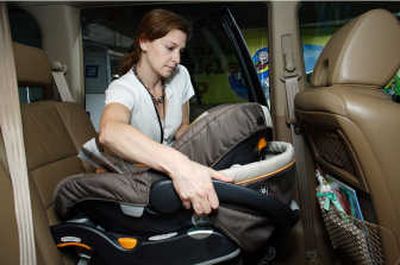Driven to safety: Parents get help keeping kids secure

Babies, as every new parent knows, don’t come with instruction manuals.
Car seats do.
But the installation instructions can be as confusing as astrophysics, leaving many parents wondering whether they’re properly hauling their most-precious cargo.
“It’s not as simple as one might think,” says Christina Janssen, a Spokane Valley resident and mom of a 9-month-old son.
Janssen read a recent Spokesman-Review article about a mother facing vehicular homicide charges after her infant daughter died in a car accident. Investigators allege the baby’s car seat was not properly installed.
So, Janssen decided she would like to make sure her son’s car seat is secured the correct way. After calling several agencies, she had a hard time finding someone in the area to inspect the seat, she says.
“It should be easier for people to be able to find this type of information,” Janssen says. “Especially when you’re open to future prosecution.”
A variety of agencies and organizations in the area offer car-seat instruction and checks, either through regularly scheduled programs or by appointment.
The Safe Kids Spokane coalition, part of the Spokane Regional Health District, works with all of those groups to spread community awareness about car-seat safety, says coalition coordinator Marion Lee.
“We all want to do it right,” Lee says. “We all want to do it right, but it’s very complicated.”
Lee, herself the mother of a 10-month-old son, “thought my seat was in right and it’s not quite tight enough,” she says.
That’s one of the most-common issues car-seat inspectors run into, they say. A properly installed seat should not have more than one inch of wiggle room on either side of its connection points with the vehicle.
Officer Teresa Fuller with the Spokane Police Department is one of about 10 officers who’ve taken a 40-hour course to become certified car-seat technicians. Fuller, mother of a 4-year-old son and a 1-year-old daughter, realized she had aligned the straps of her son’s car seat incorrectly after she turned his car seat around.
“A lot of the confusion happens when parents turn the car seat around from rear- to forward-facing,” she says. “It’s not parents not wanting to keep their children safe. If that was the case, we wouldn’t see them in car seats at all. It’s just a lack of understanding. The car-seat manuals were written by attorneys.”
Another common problem is placement of the “retainer clip,” that holds the two shoulder straps together, inspectors say. It’s supposed to be aligned with the child’s armpits, not down at stomach level where it could do serious damage in a crash.
And, the harnesses must be snug. You shouldn’t be able to gather up and pinch any slack webbing between your fingers.
Bulky winter clothing can also inhibit the car seat’s effectiveness, Fuller says. She recommends taking off coats before buckling in and laying the coat over the child for warmth.
Also, parents should look around the car for any unrestrained objects that could become deadly projectiles in an accident, says Deb Chazell, a rehabilitation aide and certified child passenger safety technician with Shriner’s Hospital for Children in Spokane.
Chazell once met a boy who needed stitches in his forehead after a small toy car hit him when the car he was riding in crashed. Imagine what might have happened with a larger object, she says.
“Better go home and clean out the car,” she advises.